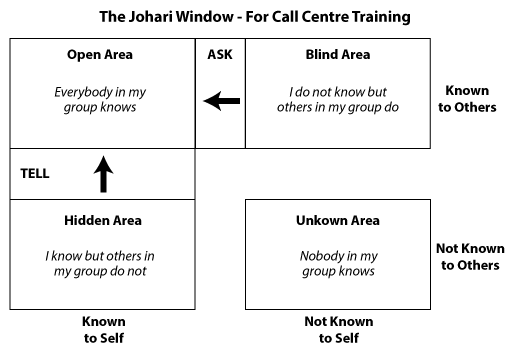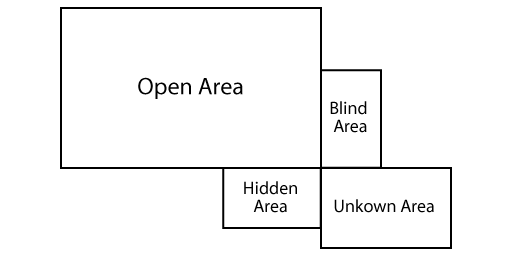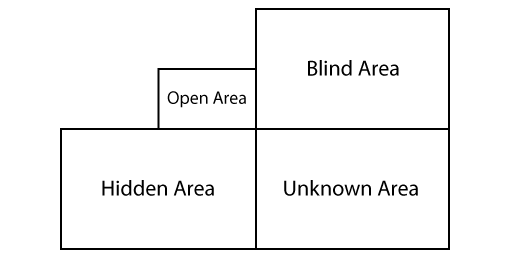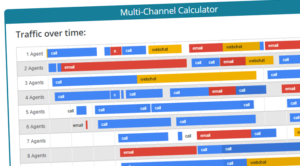Put simply, the Johari Window is a tool for helping advisors to share their knowledge with the rest of the contact centre team.
While this was not created for the contact centre per se, it is a useful tool designed by psychologists Joseph Luft and Harrington Ingham. In fact, the name Johari combines the first names, Joe and Harrington.
For the best continual learning, advisors need a platform to interact successfully and discuss organisational policies, business products, services and sales techniques.
So, instead of running through the traditional refresher training, try using the Johari Window by following this three-stage process.
How to Use the Johari Window
STEP 1 – Give a List of Duties to Individual Advisors and Ask Them to Answer Confident/Not Confident
The first step in successfully using the Johari Window is to create a list of techniques, call types and business products/services and then give that list to individual advisors.
For example, the contact centre could ask each advisor a list of questions such as:
- Are you confident in using reflective listening?
- Are you confident in handling angry customers?
- Are you confident in your knowledge of our X product range?
Advisors would then be asked to respond to each question on the list by stating whether they are confident/not confident in using that technique, handling that call type or that they have a good understanding of the specific product/service.
STEP 2 – Group Advisors and Ask Them to Discuss Their Answers
Once advisors have listed their responses, group the individuals into small teams of four to six people and ask them to categorise each of their responses, to each of the questions, into the following grid.

Once each of the advisors has organised their answers into each of the four grids, the responses included in the Open Area can be set aside, as everyone is confident with the matter.
Then, advisors should ASK the others in their group for advice about techniques, call types and business products that they were not confident with and that others said they were, i.e. responses in the Blind Area.
Also, advisors who are confident on a certain matter should share their advice and TELL the others in the group who asserted that they were not confident with this matter, i.e. matters in the Hidden Area.
STEP 3 – Matters in the Unknown Area
Hopefully, by the end of the group discussion, advisors will have more responses in the Open Area of the grid than at the beginning of the session.
But there is an issue when all of the advisors in the group are not confident in handling a certain call type, using a specific call handling technique or in their knowledge of a product/service.
In these incidences, the team leader should be “called over” to clarify the situation and help the advisors to increase their knowledge in these areas.
Also, if many groups of advisors have the same “not confident” response to the same question in their “Unknown Area”, it may be a sign that the contact centre needs to do more in this area during induction training and further ahead.
For example, maybe user guides to product/services need to be installed on desktops, or the basics of call handling techniques displayed on the contact centres wallboards, in PowerPoint or DVD form.
Also, if advisors are struggling to handle certain call types, maybe simple process flows or script examples from successful calls could be given to them. This may not be for the advisor to follow exactly but to allow them to gain a greater understanding of how these call types can be handled effectively.
For more on showcasing learning material in the contact centres, read our article: What Information Should You Be Displaying on Your Contact Centre Wallboards?
Why Is This a Good Training Activity?
Here are three reasons why contact centres should use the Johari Window when training advisors.
It Highlights Weak Spots in the Team’s Performance
Many contact centres will have refresher training that involves a lecture about parts of the job that nearly all advisors are confident with, while not addressing matters of the utmost important to the team.
This is a prime example of how to disengage advisors during coaching sessions and, consequently, waste time, something most contact centres can’t afford to do.
But, by using the Johari Window, the contact centre can filter all matters that it deems important down to those that are causing the most confusion to advisors.
This practice therefore allows the team to fill in one another’s knowledge gaps, meaning that instead of listening to a general lecture, training becomes personalised to an individual’s needs.
It Encourages Peer-to-Peer Knowledge Sharing
By asking advisors to share their advice with one another, the contact centre is encouraging conversation within the team about improving performance.
For example, during training one advisor may say to their group that they are not confident in building rapport. Then, a different advisor, who says that they are confident in building rapport, can give them a piece of advice to help them improve.
By asking advisors to share their advice with one another, the contact centre is encouraging conversation about improving performance, within the team.
Let’s say that piece of advice was to smile, as “although a customer may not be able to see it”, the confident advisor says, “they definitely can hear it.”
If the advisor was to then use this advice in practice, and started to consciously make an effort to smile more, they might then notice an improvement in their customer relationships.
This positive outcome could result in advisors turning to one another instead of going to management with their problems, freeing up the leaders’ time to get on with their other duties.
Building this culture of knowledge sharing is a great way of developing an advisor’s skill set and boosting efficiency in the contact centre.
To find more tips on improving rapport, read our article: Top Tips for Building Rapport Over the Phone
It Emphasises Areas in Which the Contact Centre Can Do More
While much of the beauty of the Johari Window lies in the Hidden and Blind areas, as this is the space for knowledge sharing between advisors, the Unknown Area also has great value.
Any responses to questions listed in this quadrant should be an alarm in the ear of any contact centre manager, as it is a signal that advisors have not been trained to an acceptable standard in handling the call type, using the technique or understanding the product/service in question.
So, these are the areas where the contact centre needs to improve its induction training, support materials and/or general education.
The Issue With the Johari Window
While there are many benefits of using the Johari Window, like many other training tools, it does have its downside, which involves the disparity between a person’s perceived understanding and reality. So, while an advisor may be confident about one thing, they might still be missing some key information.
To clarify this point, consider Gilderoy Lockhart from Harry Potter. Gilderoy considered himself highly capable, gifted, and talented, but reality proved his ineffectiveness and limitations. This makes Gilderoy the perfect example of how personal perception can predispose reality.
So, when come it comes to magic, not the call centre in this case, Gilderoy Lockhart would see his Johari Window as thus:

Reality would suggest the following might be truer:

This example emphasises the importance of advisors being honest when answering confident/not confident, so that they can be given the right information by others in the group to “fill” their knowledge gaps. This means that advisors should answer without fear of judgement by team leaders/managers when giving their responses.
So advisors should be given freedom to talk amongst themselves, and the team leaders or coach should only get involved when discussing the questions included in the “Unknown Area”.
Conclusion
The Johari Window can be a great training tool to help filter down to the issues that are causing contact centre advisors the greatest amount of grief, while highlighting areas where training can be improved.
In addition, it involves only a simple three-step process and will hopefully encourage greater discussion on the contact centre floor on how to improve performance.
However, for use of the Johari Window to be successful, advisors must be comfortable to be honest about their knowledge gaps. So, it’s important to give groups of advisors the space to be honest with one another.
Then, hopefully, advisors will be left with some personalised ideas of how to improve their performance, while the contact centre has a greater insight into where it might be going wrong.
With thanks to Dave Salisbury, an Operations and Customer Relations Specialist, for his help in putting together this article.
What other training tools/models have you used in the contact centre? How successful have they been?
Please share your thoughts in an email to Call Centre Helper.
References
Ekanayake, S. (2004). Agency theory, national culture, and management control systems.Journal of American Academy of Business, Cambridge, 4(1), 49-54. Retrieved from: http://search.proquest.com/docview/222857814?accountid=35812
Emirbayer, M., & Mische, A. (1998). What is agency? The American Journal of Sociology, 103(4), 962-1023. Retrieved from: http://www.jstor.org/stable/2782934
Greenwald, H. P. (2008). Organizations: Management without control. Thousand Oaks, CA: Sage Publications.
Kuhn, T. S. (1996). The structure of scientific revolutions. (Third ed., Vol. VIII). Chicago, IL:The University of Chicago Press.
Tosi, H. L. (2009), Theories of organization. Thousand Oaks, CA: Sage Publications.
Author: Dave Salisbury
Reviewed by: Jonty Pearce
Published On: 29th Jan 2018 - Last modified: 14th Aug 2025
Read more about - Skills, Communication Skills, Dave Salisbury, Knowledge Management, Skill Development, Training and Coaching





































